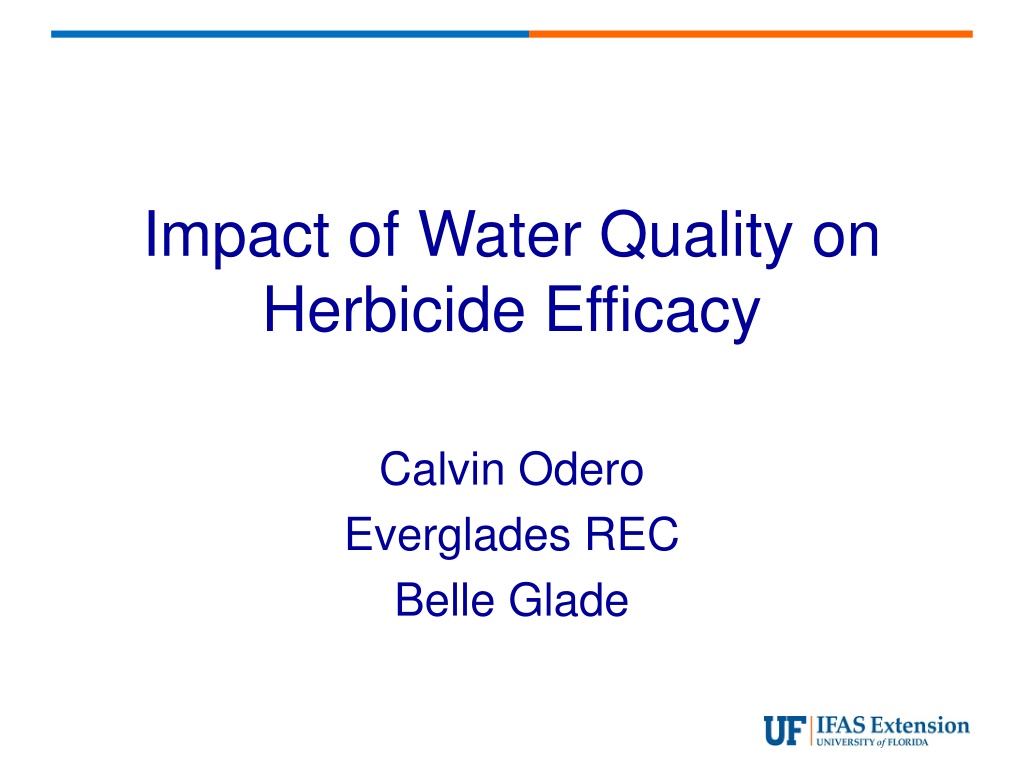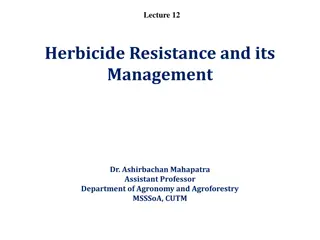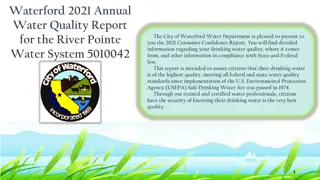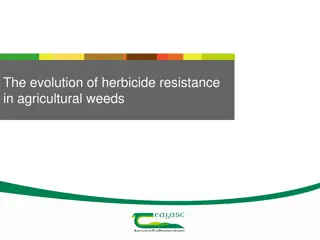Understanding the Impact of Water Quality on Herbicide Efficacy
Water quality plays a crucial role in determining the effectiveness of herbicides. Factors such as water pH, hardness, turbidity, and dissolved materials can influence herbicide efficacy. The interaction between water chemistry and herbicide chemistry is essential for successful applications. Different herbicide chemistries, including weak acids, react differently based on water composition. Monitoring water quality parameters is vital for optimizing herbicide performance and achieving effective weed control.
Download Presentation

Please find below an Image/Link to download the presentation.
The content on the website is provided AS IS for your information and personal use only. It may not be sold, licensed, or shared on other websites without obtaining consent from the author. Download presentation by click this link. If you encounter any issues during the download, it is possible that the publisher has removed the file from their server.
E N D
Presentation Transcript
Impact of Water Quality on Herbicide Efficacy Calvin Odero Everglades REC Belle Glade
Water Quality and Herbicides Water is the primary carrier for herbicide applications Spray solutions commonly contain 95% or more water Interaction is determined by water chemistry and herbicide chemistry
Water Chemistry Water pH, hardness, alkalinity, and turbidity can affect herbicide efficacy Water pH is the concentration of H+ions in the water Hard water is caused by high levels of calcium, magnesium, sodium, or iron
Water Chemistry Hardness is expressed as an equivalent of calcium carbonate in water analysis tests Turbidity is caused by suspended solids, soils, or organic matter Alkalinity refers to carbonate and bicarbonate levels in water
Common Dissolved Materials Below are the 6 most common ions found in water Other ions can also have an effect Cations (+ charge) Calcium Magnesium Sodium Anions (- charge) Sulfate Chloride Bicarbonate
TSD and EC The sum of all the minerals dissolved in a water sample is the TSD TSD is total dissolved solids The higher the TDS, the more electrical current water can conduct EC is electrical conductivity EC is used as a simple method to test for TSD
Turbidity The dirt and color you see in the water They can easily deactivate herbicides with Koc values Clean water is very important for these herbicides Herbicides with low Koc values are not affected
Herbicide Chemistry Weak acids-compounds that release some H+ ions when dissolved in water Many herbicides are weak acids: glyphosate, paraquat, sethoxydim Weak acid herbicides partially dissociate in water For most herbicides, the portion that does not dissociate is more easily absorbed by plant leaves
Herbicide Chemistry The solubility of sulfonylurea herbicides (Envoke, Sandea) increases with higher pH The amount of dissociation depends on the pH of the water Dissociated herbicide molecules have a negative charge Herbicides with high Koc values are sensitive to turbid water Koc is the organic carbon sorption coefficient
Glyphosate Hardness higher than 350 mg/L can affect low rates and over 700mg/L can affect high rates Glyphosate has a high Koc and is greatly affected by turbidity Effects can be reduced by Using higher rates Adding ammonium sulfate to the spray solution Using the spray immediately after mixing Reducing carrier volume
2,4-D Amine Water hardness levels of above 600 mg/L will likely cause interference Alkalinity above 500 mg/L can reduce effectiveness Consider alternate formulations or water sources
Clethodim, Sethoxydim, others These grass herbicides are weak acids Have low Koc values so they aren t affected by turbidity At pH values below 6 they are not affected by hard water Higher pH allows dissociation and cation formation
Koc Values of Herbicides Commonly used in the EAA 2,4-D, Ametryn, Asulam, Atrazine, Dicamba, Diuron, Halosulfuron, Hexazinone, Metribuzin, Sethoxydim, Trifloxysulfuron-low Fluazifop- moderate Glyphosate, Pendimethalin- high Paraquat-very high























